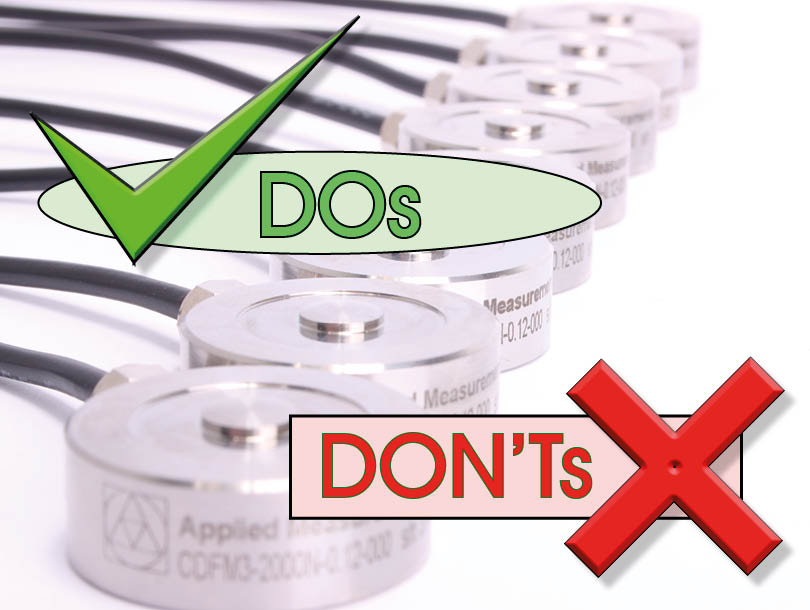Applied Measurements’ Top Tips on How to Keep Your Load Cell Working
 We all want an easy life and so does your load cell. Load cells are sensitive measuring instruments so care in both selection and handling will save you precious time and money and keep your load cell working correctly. A well-cared-for load cell reward you with:
We all want an easy life and so does your load cell. Load cells are sensitive measuring instruments so care in both selection and handling will save you precious time and money and keep your load cell working correctly. A well-cared-for load cell reward you with:
- Less Maintenance Costs
- Less Repair Costs
- Less Costly Downtime
As Bob Davies, Applied Measurements’ Production Director knows “We see time and time again load cells coming in for repair due to easily avoided errors.” So, here are our important load cell dos and don’ts to help you when asking that important question…how to keep your load cell working.
✔Let’s Start With the Load Cell Dos
✔ Always Choose the Correct Type of Load Cell for Your Application
Think about what you need to measure, the environment the load cell will be in, what accuracy it needs to have. But what if I don’t know which one to choose? Our expert technical team can help you with that. Or have a browse through our wide range of load cells we supply.
✔ Choose the Right Capacity
Work out what your minimum and maximum capacities are going to be and select a load cell with a higher capacity than the maximum, to avoid overloading the sensor and to keep your load cell working.
✔ Know Your Application Environment
Will it be wet, dusty, humid, cold? Is the load cell going to be used indoors or outdoors? Knowing these conditions before you choose your load cell guarantees it will be able to cope within the application environment.
✔ Always Use the Correct Power Supply for Your Load Cell
This will avoid electrical power surges and short circuiting of the load cell. These details can easily be found on the datasheet or the calibration certificate provided from your load cell supplier.
✔ Always Check the Datasheet or Calibration Certificate
The load cell’s specifications will tell you its environmental protection (IP rating), recommended power supply, capacity, accuracy, temperature ranges, its input and output resistance plus other key information. All these details will help you ensure your load cell leads a long and maintenance-free life. See our glossary to help you understand the datasheet terminology.
✔ Always Mount Compression Load Cells on Flat, Sturdy and Clean Surfaces
Uneven mounting can lead to flawed data and may damage the load cell.
✔ Make Sure That Everything Is Correctly Aligned
Alignment with the force path is vital for optimum accuracy regardless of whether you are measuring in tension or compression. In the case of tension rod-end bearings will help keep everything in a straight line, while in compression applications it is necessary ensuring that the surfaces compressing the load cell are flat and parallel with each other.
✔Take Care When Installing Your Load Cell
Excessive force, twisting or over-tightening can damage the load cell and lead to inaccurate results.
✔ Continually Carry Out Visual Checks on Your Load Cell
Check for damage on the load cell body i.e. corrosion, dents, cracks. Check the cable assembly and cable for cuts or wear. Damage to the cable or load cell can lead to moisture and dust ingress causing your load cell to malfunction.
✔ Check the Storage and Operating Temperature of the Load Cell
Continually monitor the environmental temperature of the load cell to ensure it is working within its guidelines. If you need a load cell for extreme temperatures make sure it has been temperature compensated. If you’re unsure contact our technical team.
☓ Load Cell Don’ts
☓ Don’t use a Lower IP Rated Load Cell than Your Environment Requires
For harsh environments use a load cell with a high protection rating. Only use a submersible load cell in a submersible application and don’t forget to check its depth rating. Still unsure? Check out our guide to IP ratings.
☓ Don’t Pull or Move the Load Cell by its Cable
You could damage not only the cable but the cable assembly and the load cell itself.
☓ Don’t Operate Load Cells Above Their Rated Capacity
This can lead to overloading and damage to the load cell. Low capacity load cell with ranges up to 25kg or so are particularly delicate so take great care when handling and installing them.
☓ Don’t Over-Tighten Mounting Bolts or use Excessive Force
Take care when installing your load cell. The load cell can be severely damaged by excessive force, over-straining and twisting.
☓ Don’t Cut the Load Cell Cable
Cable alterations should be made before the load cell has been calibrated as small changes in the resistance of the cable can lead to errors.
Find this article interesting? Have a read of our other sensor reference articles.
Using our how to keep your load cell working guide and handling your load cell with care, will easily avoid damaging the load cell causing you costly repair and downtime. If you think your load cell has been damaged, let us call you…
Why Us?
- Suppliers of top-quality strain gauge sensors and transducers to every corner of industry – UK and worldwide
- Over 100 years of expert transducer knowledge
- Our high-quality products all come with a 3 year warranty




